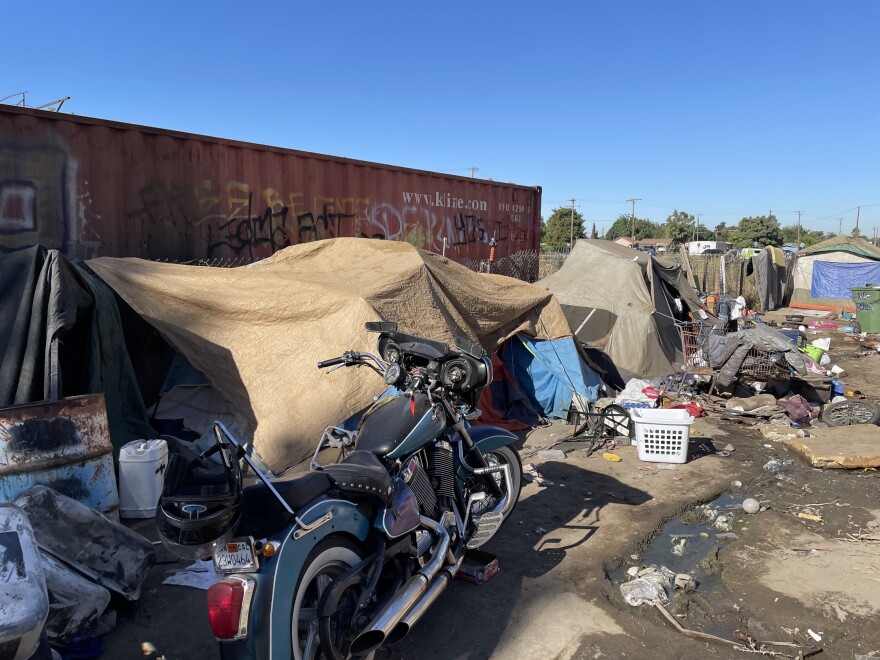Pooja Bhalla has worked with organizations for 20 years that help homeless people find a safe place to recover after leaving the hospital.
Bhalla was thrilled when California's Medicaid office announced plans in 2021 to recruit hundreds of nonprofits to provide a new suite of social services to some of the state's sickest and most expensive patients. She also knew working with Medicaid would require a complete transformation at the organization she leads.
"We were very, very worried," says Bhalla, the CEO of the Illumination Foundation in Southern California. "Like, how the heck are we going to do this?"
Bhalla, in a handful of months, had to convert her philanthropy-supported housing nonprofit into something that operated more like a doctor's office or a hospital — able to bill private health insurers and navigate Medicaid's web of regulations.
"We had to build our own billing department," Bhalla says. "There were systems that we've never had to think about before. There were different codes for each service."
Social service providers like the Illumination Foundation are key to the success of CalAIM — California's ambitious overhaul of its Medicaid program, which provides health insurance for 15 million low-income and disabled Californians. State health officials are betting that addressing people's social needs will improve health and drive down health spending long term.

CalAIM pays for someone's security deposit, medically-tailored meals and safe places to sober up. In total, California's Medicaid program now covers 14 social services all backed by evidence that they strengthen people's health. State officials also created a new benefit, known as enhanced care management, to help people navigate all of the complex medical and social service bureaucracies.
CalAIM's new service offerings primarily target the 5% of people on Medicaid in California who account for half of the program's spending. Those individuals often have multiple chronic conditions — like diabetes, heart disease or kidney failure — as well as significant social needs.
"CalAIM is really about identifying the most vulnerable individuals in Medicaid [for whom] health care services alone were not meeting their needs," says Jacey Cooper, the architect of CalAIM and former California Medicaid director.
This is the first time California's Medicaid program has paid for social service interventions statewide. Medicaid officials across the U.S. are watching to see if California can prove the theory that providing more social service support will translate into fewer expensive hospital visits, trips to the ER and nursing home stays.
California officials say it's still too soon to say if any savings from CalAIM will outweigh the costs. Nearly two years in, state data show more than 100,000 low-income Californians have received CalAIM services. But providers, insurers and Medicaid officials also recognize that missteps in CalAIM's rollout continue to leave many eligible patients on the outside looking in.
A challenging change
Nearly 500 organizations signed up to provide social services in 2022. The vast majority of them are new to Medicaid, and that transition has been rocky.
"It was like building a whole new organization," Bhalla said.
The state has handed out $800 million to help these groups build up their back-of-the-office infrastructure. Bhalla's Illumination Foundation received $1.6 million from Medicaid, but still needed nearly $2 million more in loans to complete their overhaul.

Social service providers like Bhalla say their biggest challenge has been working with the 23 private health insurers that California pays to cover people on Medicaid. The insurers include national giants like Blue Cross and Kaiser Permanente, as well as health plans run by counties and local nonprofits.
Each insurer brings their own requirements and paperwork quirks. Some health plans have felt like true partners, Bhalla said – easy to work with and responsive to her concerns. Others have consistently been difficult to reach when problems hit.
"I just can't stress enough the administrative burden with all the different health plans," Bhalla said. "We have to document in our own system. We have to document in their system. There's claims that are denied. They come back to us, we submit everything. They still don't have what they need."
Bhalla tolerates what she sees as growing pains because CalAIM continues to help some of her hard-to-reach clients every day. But she is quick to highlight that breakdowns with insurers can hurt the very people the program is supposed to help.
Bhalla tells the story of a 49-year-old patient named Gregory who was referred to the Illumination Foundation after a short stint in the hospital. (Bhalla asked to only use Gregory's first name in order to describe his experience and medical history.) Gregory was homeless and had numerous chronic medical conditions including renal disease, hypertension, diabetes and depression.
The Illumination Foundation knew Gregory needed help to get to all his medical appointments and to start looking for housing. It took his health plan six weeks to approve the service. By then, Gregory was back on the street.
Instead of getting the medical and social services CalAIM promised him, Bhalla said, Gregory has cycled in and out of the hospital a dozen times and is still without a place to live.
"He hasn't been connected to a doctor. He's not taking his medications. He needs surgery. His health is deteriorating, and if we don't get him connected to the system, it's only going to get worse," Bhalla said. "I feel like the system has failed him."
Health insurers struggle to take on their new role
The health insurance companies participating in CalAIM are easy scapegoats.
But California's Medicaid overhaul has pushed the nearly two dozen health plans to transform their own operations by folding social services into more traditional care like clinic visits and hip replacements.
To appreciate what the state is asking of providers and payers, it helps to imagine CalAIM as an orchestra. Social service providers are the musicians — a cellist here, a clarinetist there — and insurers are the conductor, responsible for assembling all the performers and making sure they're playing their part. But the CalAIM orchestra is still trying to find its rhythm.
Under CalAIM, health plans must identify which patients qualify, find organizations like the Illumination Foundation to provide services, and build a system to approve and pay for all of it.
"[Insurers] are like a deer in headlights — willing and wanting to learn, but not really knowing what the heck to do," says Kelly Bruno-Nelson, who runs CalAIM for the nonprofit health insurer CalOptima in Orange County.
Bruno-Nelson says insurers generally support CalAIM's underlying mission — better care through more holistic services. But they've struggled to build the provider capacity to meet Medicaid officials' expectations, even with significant financial support from the state.
CalOptima hired Bruno-Nelson in May 2022 after struggling to launch the program. Bruno-Nelson ran a homelessness nonprofit in Los Angeles for 15 years, and CalOptima's leaders hoped her background would help jumpstart this work.
Bruno-Nelson inked contracts with more than 120 social service nonprofits to offer CalAIM services. She then convinced her bosses to give each of the organizations $100,000 upfront, knowing the money would help them adapt to Medicaid's bureaucratic and regulatory needs.
"Oftentimes a health plan's mentality is, 'Well, we'll help you after we know that you are doing good work,'" Bruno-Nelson says. "But the issue is, how can I do good work if I don't have the money to do good work? And you go in this circle. So we said, 'OK, we're going to trust first and we're going to distribute dollars and then get the rewards afterward.'"
CalOptima also offered organizations technical assistance to negotiate Medicaid's red tape and met regularly with providers to address concerns and make quick course corrections when needed.
This "listen-first" approach helped CalOptima turn around its struggling CalAIM program. By the end of 2022, the health plan was paying for more people to get CalAIM social services than most other insurers in the state. The time-intensive approach cost the insurer more than $100 million.
"These are financial decisions," Bruno-Nelson says. "And so each health plan has to make those decisions for themselves."
Health plans have been slow to fully embrace these new services. Only three of the state's 58 counties had health plans offering all the new social services in CalAIM'a first year. But more plans are getting on board. State officials say that number had grown to 13 counties by August 2023.
A big boost to payments
Most providers and health insurers in California remain committed to CalAIM. Everyone recognized the plan to overhaul the state's Medicaid program at the end of a global pandemic would be difficult. And yet, fewer people are receiving services than initially expected, and the cumbersome paperwork has chased away some social service providers.
In response, state Medicaid officials have issued a series of reforms to shore up CalAIM including a 50% payment boost to providers. The program is also forcing insurers to streamline operations to approve services faster and standardize eligibility requirements.
"We do need to be more prescriptive," says CalAIM architect Jacey Cooper. "We needed to reduce administrative burden for the providers. We needed to increase utilization, and we needed to increase timely access to the services – because that's what we were seeing as the barriers."

Cooper says in hindsight if her office had given insurers and social service providers more time to prepare for their new roles and build stronger relationships, CalAIM's rollout might have gone smoother. It's one of many lessons she plans to share with other Medicaid officials in her new role pushing state innovation with the federal Centers for Medicare and Medicaid Services.
"Being the first is hard," Cooper says. "We're going to make a lot of the mistakes that other [states] get to come and sit around a table and [learn from]. We get to tell them all the things to do different."
Cooper believes the program is headed in the right direction in spite of the bumps. She points out that 26% of homeless Californians — some 40,000 people — received some kind of CalAIM service last year. The state this fall asked federal health officials for permission to pay for six months of rent for people who find housing through CalAIM — doubling down, in a sense, on the idea that helping people get and stay housed is part of Medicaid's job.
Cooper knows three-quarters of homeless Californians still need help. That's why she says everyone — providers, insurers and state officials — must step up to iron out the program's kinks so fewer people fall through the cracks — eligible but unable to get the care they need.
This story comes from the health policy podcast Tradeoffs, whose coverage of CalAIM is supported in part by the California Health Care Foundation. Dan Gorenstein is Tradeoffs' executive editor, and Ryan Levi is a reporter/producer for the show, where a version of this story first appeared.
Deborah Franklin edited this story. contributed to this story
Copyright 2023 TRADEOFFS. To see more, visit TRADEOFFS.


